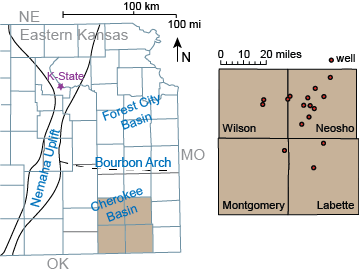Reports: UNI253188-UNI2: Field Study of Fundamental Controls on Methane Formation in a Coalbed Methane Reservoir
Matthew F. Kirk, PhD, Kansas State University
Over the past year, our research group continued working to understand the geochemistry and microbiology of coalbed methane resources in the Cherokee Basin, Kansas, USA. This past year was the fourth and final year of our project. Our efforts during previous years included sample collection (Fig. 1), laboratory geochemical and microbiological characterizations, and data analysis. Details about our previous and recent efforts and how these activities have promoted professional development are included below.
Figure 1. Location of 15 commercial coalbed methane wells we sampled for the study. At each well, we measured the pH, temperature, and electrical conductivity of water samples and we collected samples of water, gas, and microbes for laboratory analysis.
1. Field study
During years one and two, we integrated the results of our geochemical and microbiological analyses and completed a MS thesis, an undergraduate thesis, and a manuscript, which was accepted for publication in the journal Frontiers in Microbiology (Kirk et al., 2015, v. 6, article 1287). Our manuscript shows that methane in Cherokee Basin coalbeds was formed primarily by hydrogenotrophic methanogens, microorganisms that make methane by eating hydrogen. However, the proportion of methane formed by acetoclastic methanogens, microbes that make methane by eating acetate, increases with the solute content of the water (TOC figure). This trend is unexpected because it is contrary to existing conceptual models for microbial methanogenesis. It is significant because it helps us understand salinity constraints on methanogenic processes and how commercial gas production activities could influence natural gas formation.
2. Laboratory experiments
During years two and three, we tested the influence of several environmental variables on the rate of methane formation from coal and crude oil in laboratory cultures. The effort was led by undergraduate students with mentoring from me and a postdoc in the lab group. Unfortunately, the experiments did not identify any amendment that could significantly stimulate methane generation, suggesting that other aspects of the system are rate-limiting. Nonetheless, the experiment provided an opportunity for the students to gain experience with laboratory methods and applying the scientific process.
3. Geochemical tracers for produced water mixing
This past year, we carried out additional field work and data analysis to examine how our geochemical data could provide a way to evaluate sources of produced water from Cherokee Basin coalbed methane wells. The data show that chloride-bromide ratios, water isotopes, and strontium isotopes together with major ion chemistry all provide a means of identify wells that produce water from carbonate bedrock underlying the coal beds. A manuscript describing our findings is in preparation. The findings are significant because they can potentially allow energy producers to limit production of wastewater during natural gas extraction.
4. Professional development
I have used my award to fund my first graduate and undergraduate students, established a relationship with an energy industry partner, and collect a dataset that will provide a strong foundation for future energy research. The students involved have gained broad experience, which they have both successfully leveraged to get to the next steps in their career. The graduate student is now gainfully employed at a major energy company. The first undergraduate student involved in the work was successful in his application for an assistantship in graduate school and has just recently graduated. Students have also gained experience presenting their findings at two conferences.












